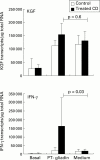Keratinocyte growth factor and coeliac disease
- PMID: 11454791
- PMCID: PMC1728384
- DOI: 10.1136/gut.49.2.176
Keratinocyte growth factor and coeliac disease
Abstract
Background: Coeliac disease is characterised by increased epithelial renewal associated with a mucosal T cell response to gliadin. Keratinocyte growth factor (KGF) is produced by cytokine activated gut stromal cells and may be a link between mucosal T cell activation in untreated coeliac disease and epithelial hyperplasia.
Aims: To characterise expression of KGF in coeliac disease.
Methods: KGF transcripts in coeliac disease were measured by quantitative competitive reverse transcription-polymerase chain reaction (RT-PCR) and localised using in situ hybridisation. KGF production by gluten reactive CD4+ T cell clones was examined. In addition, KGF transcripts were measured following ex vivo challenge of coeliac biopsies with a peptic-tryptic digest of gliadin.
Results: KGF transcripts were elevated in coeliac biopsies compared with normal controls but were not different from non-coeliac disease controls. By in situ hybridisation, KGF mRNA containing cells were present in the upper half of the lamina propria, most abundantly just under the epithelium. There was no signal from cells within the epithelium. Gluten reactive T cell clones did not make KGF. In vitro challenge of coeliac biopsies generated a strong interferon gamma response but a specific KGF response could not be detected because of an extremely high number of KGF transcripts in all cultured biopsies.
Conclusions: KGF is overexpressed in coeliac biopsies and in tissues with non-coeliac enteropathy. No evidence was found for KGF production by intraepithelial lymphocytes or lamina propria T cells.
Figures




References
Publication types
MeSH terms
Substances
LinkOut - more resources
Full Text Sources
Medical
Research Materials
